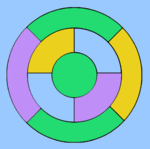Benutzer:Credner/Spielwiese2
Falsche Gegenbeispiele[Bearbeiten | Quelltext bearbeiten]
Wie viele lange Zeit offene mathematische Probleme hat auch der Vier-Farben-Satz eine große Anzahl an falschen Beweisen und Gegenbeispielen provoziert. Manche davon, wie die oben bereits erwähnten von Kempe und Tait, hielten über ein Jahrzehnt dem prüfenden Blick der Öffentlichkeit stand, bevor sie sich als falsch herausgestellt haben. Zusätzlich wurden viele andere, meist von Amateuren geschriebene falsche Beweise oder Gegenbeispiele, nie veröffentlicht.
Like many famous open problems of mathematics, the four color theorem has attracted a large number of false proofs and disproofs in its long history. Some, like Kempe's and Tait's mentioned above, stood under public scrutiny for over a decade before they were exposed. But many more, authored by amateurs, were never published at all.
Generally, the simplest "counterexamples" attempt to create one region which touches all other regions. This forces the remaining regions to be colored with only three colors. Because the four color theorem is true, this is always possible; however, because the person drawing the map is focused on the one large region, they fail to notice that the remaining regions can in fact be colored with three colors.
This trick can be generalized: there are many maps where if the colors of some regions are selected beforehand, it becomes impossible to color the remaining regions without exceeding four colors. A casual verifier of the counterexample may not think to change the colors of these regions, so that the counterexample will appear as though it is valid.
Perhaps one effect underlying this common misconception is the fact that the color restriction is not transitive: a region only has to be colored differently from regions it touches directly, not regions touching regions that it touches. If this were the restriction, planar graphs would require arbitrarily large numbers of colors.
Other false disproofs violate the assumptions of the theorem in unexpected ways, such as using a region that consists of multiple disconnected parts, or disallowing regions of the same color from touching at a point.

